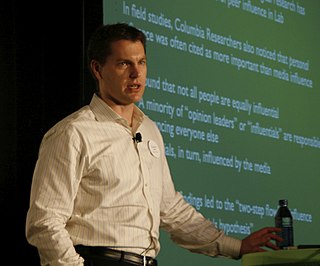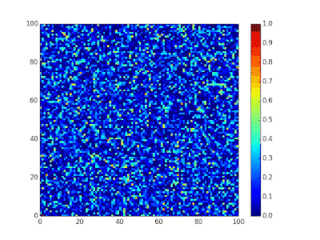
Duncan James Watts is a sociologist and a professor at the University of Pennsylvania. He was formerly a principal researcher at Microsoft Research in New York City, and is known for his work on small-world networks.

Generally speaking, a crowd is defined as a group of people that have gathered for a common purpose or intent such as at a demonstration, a sports event, or during looting, or may simply be made up of many people going about their business in a busy area. The term "the crowd" may sometimes refer to the lower orders of people in general.
In physics, the Tsallis entropy is a generalization of the standard Boltzmann–Gibbs entropy.
In the study of complex networks, assortative mixing, or assortativity, is a bias in favor of connections between network nodes with similar characteristics. In the specific case of social networks, assortative mixing is also known as homophily. The rarer disassortative mixing is a bias in favor of connections between dissimilar nodes.

A Majorana fermion, also referred to as a Majorana particle, is a fermion that is its own antiparticle. They were hypothesised by Ettore Majorana in 1937. The term is sometimes used in opposition to a Dirac fermion, which describes fermions that are not their own antiparticles.
Extremal optimization (EO) is an optimization heuristic inspired by the Bak–Sneppen model of self-organized criticality from the field of statistical physics. This heuristic was designed initially to address combinatorial optimization problems such as the travelling salesman problem and spin glasses, although the technique has been demonstrated to function in optimization domains.
Mark Newman is an English–American physicist and Anatol Rapoport Distinguished University Professor of Physics at the University of Michigan, as well as an external faculty member of the Santa Fe Institute. He is known for his fundamental contributions to the fields of complex networks and complex systems, for which he was awarded the 2014 Lagrange Prize.

Alessandro Vespignani is an Italian-American physicist, best known for his work on complex networks, and particularly for work on the applications of network theory to the mathematical modeling of infectious disease, applications of computational epidemiology, and for studies of the topological properties of the Internet. He is currently the Sternberg Family Distinguished University Professor of Physics, Computer Science and Health Sciences at Northeastern University, where he is the director of the Network Science Institute.
Subir Sachdev is Herchel Smith Professor of Physics at Harvard University specializing in condensed matter. He was elected to the U.S. National Academy of Sciences in 2014, and received the Lars Onsager Prize from the American Physical Society and the Dirac Medal from the ICTP in 2018. He was a co-editor of the Annual Review of Condensed Matter Physics from 2017-2019.

Dirk Helbing is Professor of Computational Social Science at the Department of Humanities, Social and Political Sciences and affiliate of the Computer Science Department at ETH Zurich.
Theo Geisel is a German physicist. Geisel is a director at the Max Planck Institute for Dynamics and Self-Organization and professor of theoretical physics at the University of Göttingen. His research is primarily concerned with the behavior of complex systems ranging from theoretical investigations in quantum chaos to nonlinear phenomena occurring in the brain.

Classic epidemic models of disease transmission are described in Compartmental models in epidemiology. Here we discuss the behavior when such models are simulated on a lattice. Lattice models, which were first explored in the context of cellular automata, act as good first approximations of more complex spatial configurations, although they do not reflect the heterogeneity of space. Lattice-based epidemic models can also be implemented as fixed agent-based models.
Eric R. Weeks is an American physicist. He completed his B.Sc. at the University of Illinois at Urbana–Champaign in 1992. He obtained a Ph.D. in physics from the University of Texas at Austin in 1997, working under Harry Swinney, and later completed post-doctoral research with David Weitz and Arjun Yodh at Harvard University and the University of Pennsylvania. He is currently a full professor at Emory University in Atlanta, Georgia.

Luís A. N. Amaral is a Portuguese physicist recognized for his research in complex systems and complex networks. His specific research interests include the emergence, evolution, and stability of complex social and biological systems. He is best known for his work in network classification and cartographic methods for uncovering the organization of complex networks. He is currently professor at McCormick School of Engineering and Feinberg School of Medicine, Northwestern University.
Valleytronics is an experimental area in semiconductors that exploits local extrema ("valleys") in the electronic band structure. Certain semiconductors have multiple "valleys" in the electronic band structure of the first Brillouin zone, and are known as multivalley semiconductors. Valleytronics is the technology of control over the valley degree of freedom, a local maximum/minimum on the valence/conduction band, of such multivalley semiconductors.
In mathematical modeling of social networks, link-centric preferential attachment is a node's propensity to re-establish links to nodes it has previously been in contact with in time-varying networks. This preferential attachment model relies on nodes keeping memory of previous neighbors up to the current time.

Global cascades models are a class of models aiming to model large and rare cascades that are triggered by exogenous perturbations which are relatively small compared with the size of the system. The phenomenon occurs ubiquitously in various systems, like information cascades in social systems, stock market crashes in economic systems, and cascading failure in physics infrastructure networks. The models capture some essential properties of such phenomenon.

Individual human mobility is the study that describes how individual humans move within a network or system. The concept has been studied in a number of fields originating in the study of demographics. Understanding human mobility has many applications in diverse areas, including spread of diseases, mobile viruses, city planning, traffic engineering, financial market forecasting, and nowcasting of economic well-being.

Targeted immunization strategies are approaches designed to increase the immunization level of populations and decrease the chances of epidemic outbreaks. Though often in regards to use in healthcare practices and the administration of vaccines to prevent biological epidemic outbreaks, these strategies refer in general to immunization schemes in complex networks, biological, social or artificial in nature. Identification of at-risk groups and individuals with higher odds of spreading the disease often plays an important role in these strategies, since targeted immunization in high-risk groups is necessary for effective eradication efforts and has a higher return on investment than immunizing larger but lower-risk groups.
Air transport network or air transportation network (ATN) is an example of transport networks and spatial networks. The nodes of the network are the airports and the links represent direct flight routes between two airports. Alternatively, cities can be considered as the nodes with links representing direct flight connection between them. Air transport networks can be defined worldwide as well as for one region or for one airline company; the scale of the network can be global or domestic.








